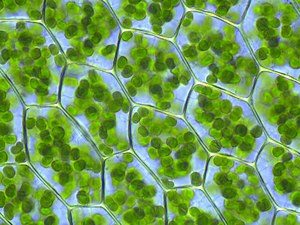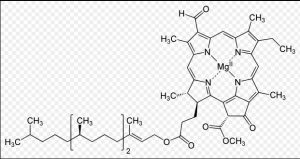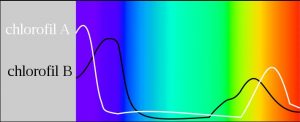We all know the basic facts about photosynthesis, or at least we all think we do. Plants use the chemical chlorophyll to absorb sunlight and use its energy to turn carbon dioxide and water into sugar. This chemical process is called photosynthesis and is the main source of food for all life on Earth. At the same time photosynthesis also produces oxygen as a by-product. So for us animals photosynthesis provides both the food we eat as well as the oxygen we breath. Oh, and chlorophyll is also the reason plants are green. See image below of plant cells, the green blobs are called chloroplasts where the chlorophyll is concentrated.

As you might guess, chlorophyll is a rather complicated chemical and not surprisingly there are several variant forms of the chemical. Looking at the chemical diagram below for chlorophyll-a the most common form, the roundish structure on the right hand side is called the chlorin magnesium ligand, which is shared by all forms of the chemical.

Biochemists have identified six other slight, yet still distinct variant form of chlorophyll. These are labeled chlorophyll-b through -f with two different c’s, -c1 and -c2. Each of these variant chlorophylls absorbs different wavelengths of visible light more or less efficiently than the others with Chlorophyll-a generally being the most efficient, which is why it is by far the most common type. The image below shows the absorption efficiency versus wavelength for chlorophyll-a and chlorophyll-b.

Of course there are wavelengths of light that are outside the visible spectrum. Infrared light is one of these and researchers have now discovered that chlorophyll-f is particularly good at using the energy of infrared light in what is being called ‘a new kind of photosynthesis’. In fact, under low light conditions photosynthesis using chlorophyll-f becomes dominant in certain species of cyanobacteria and blur-green algae.
These bacteria and algae are examples of life in extreme conditions, many live deep underwater in the boiling hot volcanic springs of Yellowstone or similar hostile environments. The ability to get energy from light that other ‘more advanced’ living things can’t use gives these single celled creatures the advantage they need to survive.
Life forms that can life in such extreme conditions are of great interest to space scientists who want to understand what life on other worlds, with very different environments, might be like. In fact Mars, further from the Sun with lower levels of light, might be the perfect environment for bacteria using the chlorophyll-f style of photosynthesis.
Some scientists have gone even further and are already suggesting that such bacteria be taken from Earth to Mars in order to start producing oxygen that one day people might breath. Importing and spreading such low light using, oxygen producing bacteria across the planet would be one of the first steps in Terraforming Mars for human habitation.
I’m certain that there’s still a great deal more to be learned about chlorophyll and the process of photosynthesis just as I’m certain scientists will keep studying it. And maybe someday soon we will find life on Mars or Europa or elsewhere and we will get the chance to learn how true aliens produce their food.
